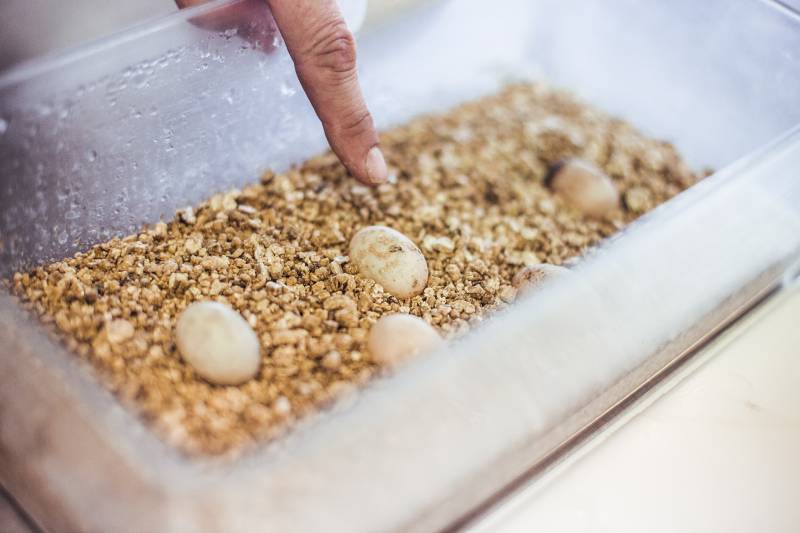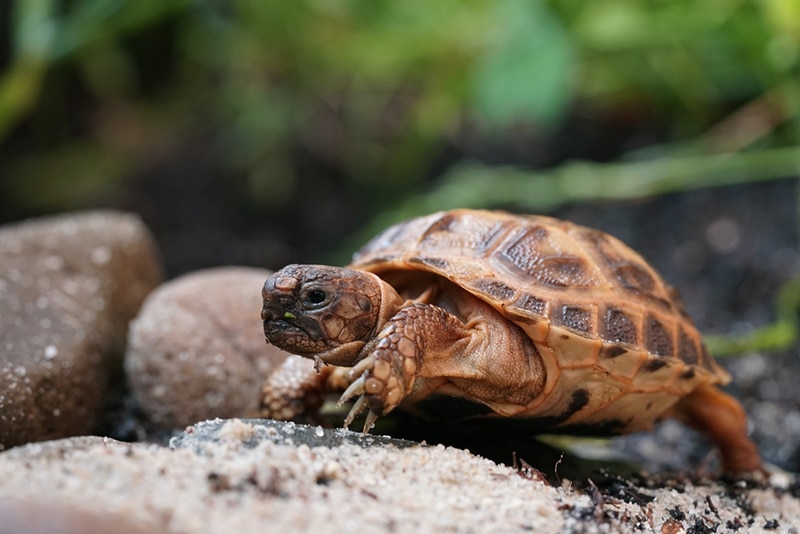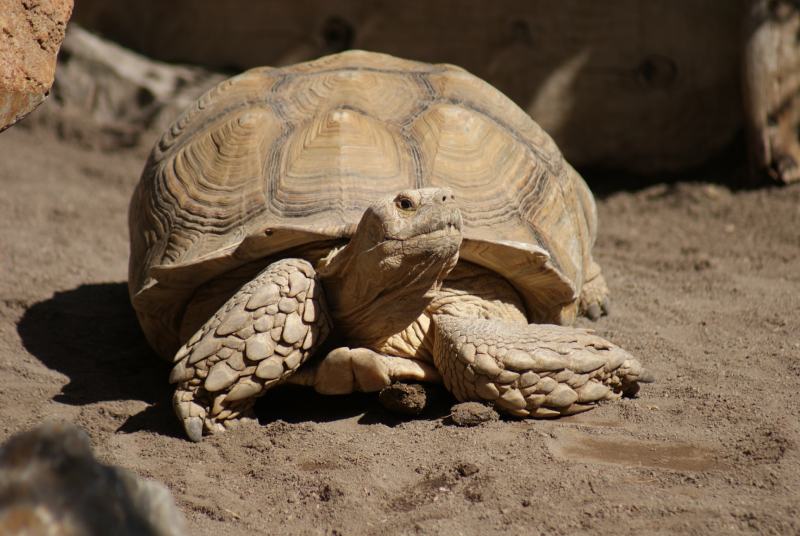How to Incubate Turtle Eggs: Step-by-Step Guide
Updated on

Click to Skip Ahead
Whether you were expecting to find eggs in your turtle’s habitat or not, seeing them for the first time can be exciting and perhaps a little scary! Your next step is to learn all you can about how to take care of the eggs, including how to incubate them.
Fortunately, incubating eggs can be easily accomplished, even if this is your first time. It just takes time, patience, and plenty of attention. How you incubate the eggs also depends on the species of turtle that you own, so let’s go through what it takes to incubate turtle eggs, step by step.
Step-by-Step Guide on How to Incubate Turtle Eggs
1. Find an Incubator
If the eggs have been laid or laying is imminent, you’ll need to set up your incubator. What kind of incubator you use depends on you, your budget, and the species of turtle that you have.
Once you have an incubator, clean it before use with warm water and dish detergent. If you have a store-bought incubator, it might come with cleaning instructions, which you should follow.
- Low Humidity
The low-humidity method is for tortoises or turtles from dry regions that lay hard-shelled eggs. For these turtles, you can use a bird egg incubator, which includes a thermostat to maintain a constant temperature.
- High Humidity
This is the most common method because it’s suitable for box and aquatic turtles. Since the eggs are sensitive to changes in temperature and humidity, it’s vital that you keep the incubator at a consistent level. Humidity should be about 80%, which is where a hygrometer can come in handy. You can purchase an incubator with a hygrometer installed; otherwise, you’ll need to buy your own separately. The temperature should be kept consistently at about 80°F (or 27°C) and not deviate from this.
2. Remove the Eggs From the Nest
Female turtles lay their eggs in a burrow or nest and cover them with sand, soil, or whatever is handy. Once the eggs are laid and covered, the female won’t go back to check on them, which enables the eggs to incubate.
Start by gently removing the eggs from the nest using either a clean paintbrush to dust off the soil or a small tool like a spoon. If the soil is packed down on the eggs, you’ll want to be extra careful digging them out.
Once the eggs have been removed, keep them in the same position that you found them, with the top of the egg facing upward. With a pencil, mark the top of the egg with an “X” or a dot. Remember that turtle eggs start out soft, so everything must be done carefully and gently.
It’s essential that the eggs are always placed with this marking on top, as turning the eggs over can be fatal to the embryos. Gently brush off any debris or dirt from the eggs, and carefully bring them to the incubator.

3. Set Up the Eggs in the Incubator
Once you have the proper equipment (thermostat, hygrometer, etc.) and the temperature and humidity levels are set, you need to fill it with the appropriate substrate. This will go a long way toward helping maintain the incubator’s conditions.
You can add moistened sphagnum moss or vermiculite or even moistened paper towels (though the moss and vermiculite will remain damp longer) to the incubator and place the eggs on top (remembering to keep the marked part of the egg facing up).
If you don’t want to splurge on an incubator, you can use something like a plastic margarine container with the lid on. You can place it in an area of your home that is slightly above room temperature. This can be above a water heater or refrigerator.
You can also place the container inside the incubator with the lid on but with holes punched out, which can help maintain the humidity.
If your incubator already comes with its own container, you don’t have to worry about using something else. Just place the moss or vermiculite inside the container, place the eggs on top, and everything goes into the incubator.
4. Time to Monitor
Now that the eggs are in the incubator, the rest of the process is about carefully monitoring the eggs and the conditions inside. How long it takes for turtles to hatch depends on the species, but it can take between 2 and 3 months, with 2 months being the average. Fluctuations in the temperature, even as little as 2 degrees, can extend the incubation time up to 3 weeks.
During incubation, you can “candle” the eggs to check the progression of the embryos. Gently pick up an egg, and hold it over a narrow beam of light (such as a pencil light). This is called candling, as that’s the light source that was used a long time ago. You should see the yolk on the bottom of the egg, and after a while, you’ll notice blood vessels forming on top of the embryo.
Once the hatching begins, you should know that not all the turtles will emerge at the same time. Any unhatched eggs should be left in the incubator for a while longer.

5. Prepare for When the Eggs Hatch
You’ll need to have an enclosure set up for the hatchlings in advance. This includes lining it with wet towels, which will keep the turtles moist. The hatchlings should remain in this enclosure until their egg sacs fall off, which might take about a week. The egg sac provides each hatchling with their required nutrients and will fall off naturally.
You’ll need to keep the towels moist this entire time, which you can accomplish by spraying them with a bottle sprayer. The shells of your new little turtles are also quite soft and fragile at this time, so they need careful handling.
Once the egg sacs have fallen off, the hatchlings will need to be moved to an enclosure with the appropriate UVB light, heat lamp, water, and the right diet.
Frequent Asked Questions (FAQ)
How Can You Tell When a Turtle Is Ready to Lay Her Eggs?
It’s important to be aware of when your turtle will lay her eggs so you can retrieve them immediately and move them to the incubator.
- She’ll explore the habitat looking for a suitable nesting place.
- She’ll dig multiple holes.
- Her walking pattern will change.
- She’ll start spending more time on land than in the water.
Once the eggs are laid, this is where you step in.
How Many Eggs Do Turtles Lay?
This depends on the species of the turtle and their age and health, but generally, turtles will lay a minimum of two eggs. Some species can lay up to 30!

Do Aquatic Turtle Eggs Hatch in the Water?
No. While it’s essential to keep the eggs moist to a certain degree, if an egg is submerged in the water, the hatchling will die.
How Long Are Eggs Laid After Mating?
This depends on the species, but the typical time range is 3 to 6 weeks after mating that the female will lay her eggs.
Conclusion
It’s not that difficult to take care of turtle eggs, but you still need to stay on top of the details. Remember that the eggs must always stay in one position and should never be turned, rotated, or shaken.
Keep the temperature in the incubator, whether homemade or store-bought, at about 80°F and the humidity at 80%. Too much fluctuation might make the incubation period longer, or the embryos might die.
You should also speak to your vet to ensure that you’re everything right; they might also have advice for you. That said, as long as you follow these steps and observe the eggs carefully, you’ll be the proud parent of a bunch of adorable little hatchlings in no time!
Featured Image Credit: Aitor Lamadrid Lopez, Shutterstock












